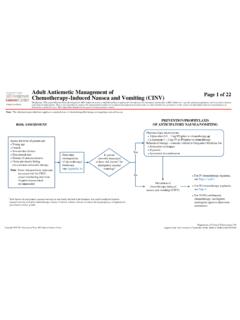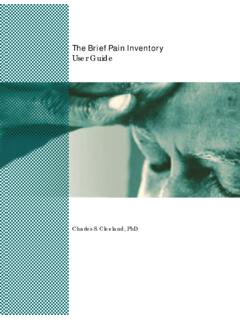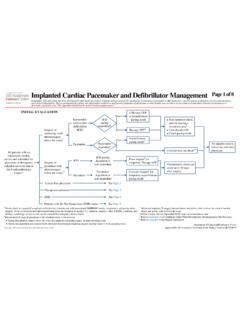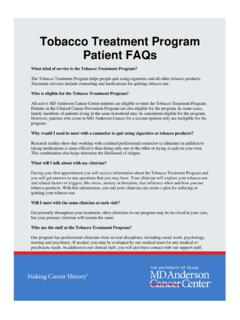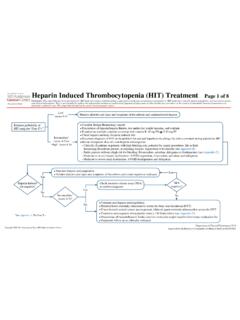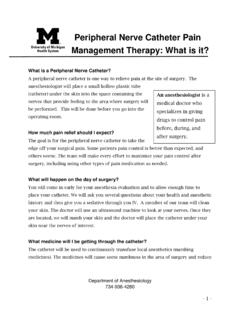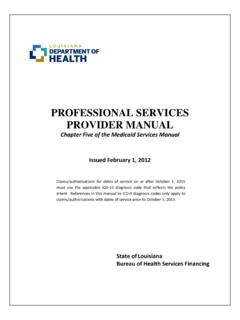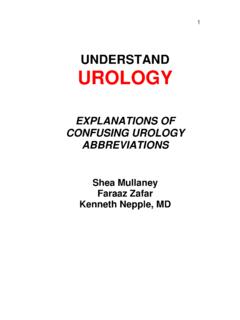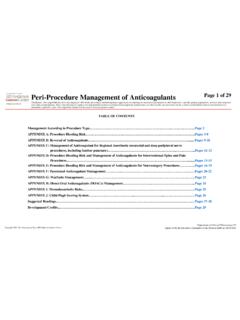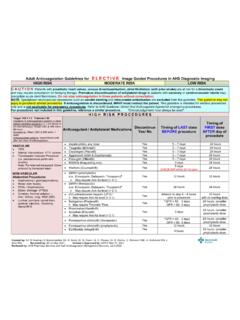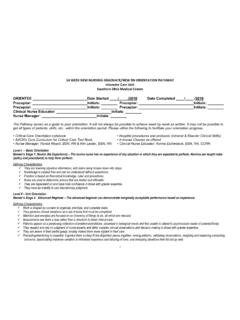Transcription of Peri-Operative Pain Management Page 1 of 21
1 Page 1 of 21 Disclaimer: This algorithm has been developed for MD Anderson using a multidisciplinary approach considering circumstances particular to MD Anderson s specific patient population, services and structure, and clinical information. This is not intended to replace the independent medical or professional judgment of physicians or other health care providers in the context of individual clinical circumstances to determine a patient's care. This algorithm should not be used to treat pregnant pain ManagementDepartment of Clinical Effectiveness V4 Approved by the Executive Committee of the Medical Staff on 10/20/2020 TABLE OF CONTENTSPost- operative pain Assessment and Treatment.
2 Pages 2-3 Quick Reference 4 APPENDIX A: Comprehensive pain Assessment ..Page 5 APPENDIX B: Non-Opioids .. Page 6 APPENDIX C: Opioid Dose Considerations ..Pages 7-8 APPENDIX D: Opioid Side Effects Prevention and Management ..Pages 9-10 APPENDIX E: Adjuvants Co-analgesics for Neuropathic pain Syndromes and Chronic pain .. Pages 11-12 APPENDIX F: Post-Op Specialty Services and Consultations Guidelines ..Page 13 APPENDIX G: Patient Controlled Analgesia (PCA) .. Page 14 APPENDIX H: Equianalgesic Opioid Dose Conversion .. Pages 15-16 APPENDIX I: Treatment .. Page 17 APPENDIX J: Fentanyl.
3 Pages 18-19 Suggested Readings ..Page 20 Development Credits ..Page 21 Note: This consensus algorithm excludes patients who are in the ICU, perioperative or pre-procedural settings, or are currently receiving epidural or intrathecal discharge planNoYes Continue monitoring Re-evaluate at appropriate intervalsPain controlled?NoYesPre- operative Evaluation Comprehensive pain assessment (see Appendix A) Determine category of procedure (minor, intermediate, major)and consider the following treatment modalities: Minor: local anesthetic infiltration, post- operative oral analgesics Intermediate: minor recommendations in addition to regionalanalgesic technique if applicable and plan for possibleintravenous analgesics post-operatively Major.
4 Intermediate recommendations in addition to benefitof starting preoperative medications if appropriate Determine previous exposure to narcotics Anesthesia assessment for PNC or epidural Consider Acute pain consult if clinically indicatedPost- operative Evaluation Complications of surgery and/or anesthesia Comprehensive pain assessment (see Appendix A) Procedures performed Physical constraints (tight straps, bandages, excessivecompression, etc.) Drain output (increased output may indicate coagulopathy) Swelling/edema Neurovascular assessment Activity restrictions/changes (ambulation, performance status,incentive spirometry, bowel function, etc.)
5 Current pain orders: PCA, epidural, PNC, or other Consider Acute pain consult if clinically indicated Consider Physical therapy /Occupational therapy consult ifclinically indicated Consider Integrative Medicine consult if indicatedPain controlled?Per surgical and anesthesia teams,is there a need for post- operative Acute pain consult?NoYesConsult Acute pain See Page 3 See Page 3 ASSESSMENTPNC = peripheral nerve catheterPCA = patient controlled analgesiaPage 2 of 21 Disclaimer: This algorithm has been developed for MD Anderson using a multidisciplinary approach considering circumstances particular to MD Anderson s specific patient population, services and structure, and clinical information.
6 This is not intended to replace the independent medical or professional judgment of physicians or other health care providers in the context of individual clinical circumstances to determine a patient's care. This algorithm should not be used to treat pregnant pain ManagementNote: This consensus algorithm excludes patients who are in the ICU, perioperative or pre-procedural settings, or are currently receiving epidural or intrathecal of Clinical Effectiveness V4 Approved by the Executive Committee of the Medical Staff on 10/20/2020 TREATMENTR eassess pain and opioid side effects at appropriate intervals as clinically indicatedNoYesPain score1 3 and/or PPG metFor patients not currently taking opioids.
7 Choose non-opioids (see Appendix B) or if contraindicated, useweak opioids (see Appendix C), as needed for painFor patients currently taking opioids: Continue current analgesic regimen if no side effects. Prescribeshort-acting opioid at 10-20% of long-acting dose every 2 to 4 hoursas needed (Appendix C for dosing) Manage opioid induced side effects and decrease/change opioids ifindicated (see Appendix D)For patients not currently taking opioids: Administer short acting opioids (see Appendix C)Note: Fentanyl should not be used in opioid na ve patientsFor patients currently taking opioids: Consider increasing scheduled opioid dose by 30-50%.
8 Calculate short-acting opioid dose as 10-20% of prior 24 hour opioid dose Manage opioid induced side effects and decrease/change opioids ifindicated (see Appendix D) Consider Acute pain consultManage both pain and psychosocial distress: Rapidly titrate short-acting opioids If significant anxiety related to pain , administer opioids prior to sedatinganxiolytics Ongoing assessment is necessary for pain , distress and opioid side effectsuntil patient stable Consider Acute pain consultSevere Pain2 pain not controlledContinue current treatmentConsult Acute Pain1 See Appendix A2 Severe pain , new onset, or exacerbation of previously stabilized pain , accompanied by significant distress or if present for > 24 hoursPain controlled?
9 Note for all patients: If patient has a regional anesthetic block, notify appropriate managing service Consider using appropriate adjuvants (see Appendix E), prevention and Management of opioid side effects (see Appendix D) and/or Integrative Medicine Services such as acupuncture or mind-body therapies (see Appendix F), Physical therapy , patient education, and psychosocial support as appropriate If frequent prn doses required and pain anticipated for greater than one day, consider patient controlled analgesia (PCA). See Appendix score1 4 and/or PPG not metPPG = personalized pain goalNote: This consensus algorithm excludes patients who are in the ICU, perioperative or pre-procedural settings, or are currently receiving epidural or intrathecal 3 of 21 Disclaimer: This algorithm has been developed for MD Anderson using a multidisciplinary approach considering circumstances particular to MD Anderson s specific patient population, services and structure, and clinical information.
10 This is not intended to replace the independent medical or professional judgment of physicians or other health care providers in the context of individual clinical circumstances to determine a patient's care. This algorithm should not be used to treat pregnant pain ManagementDepartment of Clinical Effectiveness V4 Approved by the Executive Committee of the Medical Staff on 10/20/2020 Page 4 of 21 Disclaimer: This algorithm has been developed for MD Anderson using a multidisciplinary approach considering circumstances particular to MD Anderson s specific patient population, services and structure, and clinical information.
